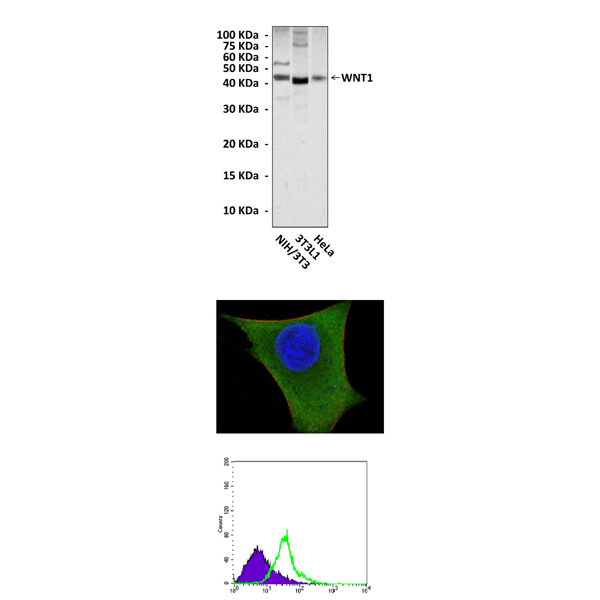Product Sheet CP10245
Description
BACKGROUND The Wnt genes encode a large, highly conserved family of cysteine-rich secreted glycoproteins that play essential roles in controlling tissue patterning, cell fate and proliferation from Drosophila to humans. There are 19 mammalian Wnt proteins identified and all bind to frizzled (Fzd) cell surface receptors to initiate cellular responses. The members exhibit unique expression patterns and distinct functions in development. They can be divided into three distinct types based on their ability to induce transformation of the mouse mammary epithelial cell line C57MG. The highly transforming members include Wnt-1, Wnt-3a, and Wnt-7a. The intermediately transforming members include Wnt-2, Wnt-5b, and Wnt-7b and nontransforming members are Wnt-4, Wnt-5a, Wnt-6, and Wnt-11. They signal through either the canonical pathway or at least two different noncanonical pathways. In short, the canonical Wnts signal through nuclear beta catenin/Tcf-Lef while the noncanonical Wnts function through alternate signaling cascades that include Ca++/PKC, RhoA/JNK or RhoB/Rab4. In addition to secreted Wnt glycoproteins, the Wnt signaling network also includes several extracellular secreted regulators that antagonize Wnt actions including secreted frizzled-related proteins (Sfrps), Wnt inhibitory factors (Wif), and the dickkopf (Dkk) proteins which specifically block canonical Wnt signaling. Mutations in Wnt genes or Wnt pathway components lead to specific developmental defects, while various human diseases, including cancer, are caused by abnormal Wnt signaling.1
Wnt-1 was first identified as a proto-oncogene activated in mouse mammary tumors induced by mouse mammary tumor virus. It is conserved in evolution, and the protein encoded by this gene is known to be 98% identical to the mouse Wnt1 protein at the amino acid level. Wnt-1 signal is a secreted glycoprotein that plays important roles in embryonic development and carcinogenesis. It is likely to signal in short range just over only few cell diameters. The studies in mouse indicate that the Wnt1 protein functions in the induction of the mesencephalon and cerebellum. It plays important role in CNS development.2 In a conditional Wnt-1 transgenic mouse tumor model, reduction of Wnt-1 signaling results in the regression of the Wnt-1 initiated primary mammary tumors and lung metastasis. Aberrant activation of the Wnt pathway has been strongly linked to the development of human cancers. Increased Wnt-1 signal has been found in a variety of human cancers. Once upregulated, secreted Wnt1 acts as an autocrine and/or paracrine factor and initiates a cascade of cytoplasmic signaling events leading to the phosphorylation of glycogen synthase kinase 3beta (GSK-3beta) and inhibition of its ability to phosphorylate beta-catenin. Stabilized beta-catenin translocates to the nucleus, leading to the stimulation of Wnt-target genes.3
Wnt-1 was first identified as a proto-oncogene activated in mouse mammary tumors induced by mouse mammary tumor virus. It is conserved in evolution, and the protein encoded by this gene is known to be 98% identical to the mouse Wnt1 protein at the amino acid level. Wnt-1 signal is a secreted glycoprotein that plays important roles in embryonic development and carcinogenesis. It is likely to signal in short range just over only few cell diameters. The studies in mouse indicate that the Wnt1 protein functions in the induction of the mesencephalon and cerebellum. It plays important role in CNS development.2 In a conditional Wnt-1 transgenic mouse tumor model, reduction of Wnt-1 signaling results in the regression of the Wnt-1 initiated primary mammary tumors and lung metastasis. Aberrant activation of the Wnt pathway has been strongly linked to the development of human cancers. Increased Wnt-1 signal has been found in a variety of human cancers. Once upregulated, secreted Wnt1 acts as an autocrine and/or paracrine factor and initiates a cascade of cytoplasmic signaling events leading to the phosphorylation of glycogen synthase kinase 3beta (GSK-3beta) and inhibition of its ability to phosphorylate beta-catenin. Stabilized beta-catenin translocates to the nucleus, leading to the stimulation of Wnt-target genes.3
REFERENCES
1. Wodarz, A. et al: Annu. Rev. Cell Dev. Biol. 14: 59–88, 1998
2. Echelard, Y. et al: Development 120:2213-24, 1994
3. Wei, W. et al: Mol. Cancer 8:76, 2009
2. Echelard, Y. et al: Development 120:2213-24, 1994
3. Wei, W. et al: Mol. Cancer 8:76, 2009
Products are for research use only. They are not intended for human, animal, or diagnostic applications.

(Click to Enlarge) Top: Western Blot detection of WNT1 proteins in various cell lysates using WNT1 Antibody. Middle: This antibody stains HeLa cells in confocal immunofluorescent analysis (WNT1 Antibody: Green; Actin filaments: Red; DRAQ5 DNA dye: Blue). Bottom: It also specifically detects WNT1 proteins in HeLa cells by FACS assay (WNT1 Antibody: Green; control mouse IgG : Purple)
Details
Cat.No.: | CP10245 |
Antigen: | purified recombinant human WNT1 fragments expressed in E. coli. |
Isotype: | Mouse IgG1 |
Species & predicted species cross- reactivity ( ): | Human, Mouse, Rat |
Applications & Suggested starting dilutions:* | WB 1:1000 IP n/d IHC n/d ICC 1:200 FACS 1:200 |
Predicted Molecular Weight of protein: | 42 kDa |
Specificity/Sensitivity: | Detects endogenous WNT1 proteins without cross-reactivity with other family members. |
Storage: | Store at -20°C, 4°C for frequent use. Avoid repeated freeze-thaw cycles. |
*Optimal working dilutions must be determined by end user.
Products
| Product | Size | CAT.# | Price | Quantity |
|---|---|---|---|---|
| Mouse WNT1 Antibody: Mouse WNT1 Antibody | Size: 100 ul | CAT.#: CP10245 | Price: $413.00 |
